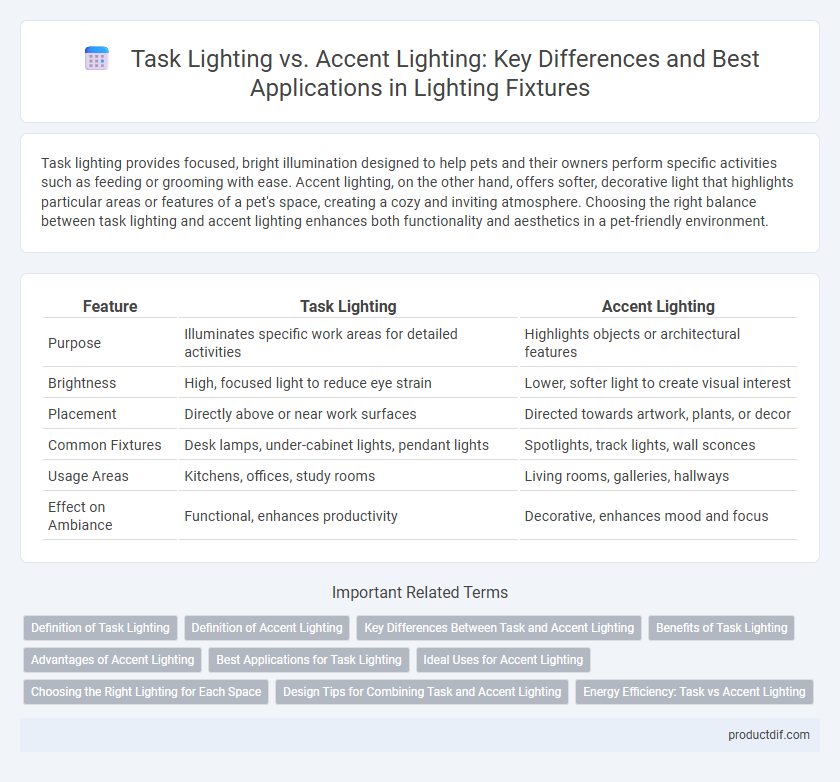Task lighting provides focused, bright illumination designed to help pets and their owners perform specific activities such as feeding or grooming with ease. Accent lighting, on the other hand, offers softer, decorative light that highlights particular areas or features of a pet's space, creating a cozy and inviting atmosphere. Choosing the right balance between task lighting and accent lighting enhances both functionality and aesthetics in a pet-friendly environment.
Table of Comparison
| Feature | Task Lighting | Accent Lighting |
|---|---|---|
| Purpose | Illuminates specific work areas for detailed activities | Highlights objects or architectural features |
| Brightness | High, focused light to reduce eye strain | Lower, softer light to create visual interest |
| Placement | Directly above or near work surfaces | Directed towards artwork, plants, or decor |
| Common Fixtures | Desk lamps, under-cabinet lights, pendant lights | Spotlights, track lights, wall sconces |
| Usage Areas | Kitchens, offices, study rooms | Living rooms, galleries, hallways |
| Effect on Ambiance | Functional, enhances productivity | Decorative, enhances mood and focus |
Definition of Task Lighting
Task lighting is a type of lighting fixture designed to provide focused illumination for specific activities such as reading, cooking, or working at a desk. It enhances visibility and reduces eye strain by directing bright, concentrated light exactly where it is needed. Common examples include desk lamps, under-cabinet lights, and adjustable floor lamps.
Definition of Accent Lighting
Accent lighting enhances visual interest by highlighting specific objects or architectural features, creating depth and focal points in a space. This type of lighting typically uses directional fixtures such as spotlights or track lights with focused beams to draw attention to artwork, sculptures, or textured walls. Unlike task lighting, which provides functional illumination for activities, accent lighting is primarily decorative and emphasizes aesthetic appeal within interior design.
Key Differences Between Task and Accent Lighting
Task lighting provides focused, bright illumination designed to enhance visibility for specific activities such as reading, cooking, or working at a desk, ensuring precision and reducing eye strain. Accent lighting highlights architectural features, artworks, or decorative objects to create visual interest and depth, often using adjustable spotlights, track lighting, or wall sconces. The key difference lies in functionality: task lighting prioritizes practicality and clarity, while accent lighting emphasizes aesthetics and ambiance.
Benefits of Task Lighting
Task lighting enhances productivity by providing focused illumination specifically designed for activities like reading, cooking, or office work, reducing eye strain and improving accuracy. It offers adjustable brightness and direction, allowing users to customize light intensity based on individual needs and the specific task. These benefits make task lighting essential in both residential and commercial environments for improving efficiency and comfort.
Advantages of Accent Lighting
Accent lighting enhances visual interest by drawing attention to architectural features, artwork, or decorative elements, creating depth and dimension in a space. It offers energy efficiency by using focused beams, reducing overall illumination needs while highlighting specific areas. This type of lighting also contributes to setting a mood or ambiance, adding warmth and character without overwhelming the environment.
Best Applications for Task Lighting
Task lighting provides focused illumination designed to enhance visibility during specific activities such as reading, cooking, or working at a desk, making it ideal for kitchens, offices, and study areas. High-intensity LED desk lamps, under-cabinet lights, and adjustable floor lamps are common task lighting fixtures that reduce eye strain and increase productivity. Prioritizing task lighting in workspaces and detailed-oriented environments ensures optimal performance and safety.
Ideal Uses for Accent Lighting
Accent lighting enhances architectural features, artworks, and decorative elements by creating focused illumination that draws attention and adds visual interest. It is ideal for highlighting textured walls, sculptures, plants, and display shelves, transforming ordinary spaces into dynamic, engaging environments. This type of lighting complements task lighting by providing layered depth and ambiance without overwhelming primary functionality.
Choosing the Right Lighting for Each Space
Task lighting provides focused illumination ideal for activities such as reading, cooking, or working, ensuring maximum visibility and reduced eye strain. Accent lighting highlights architectural features, artwork, or decorative elements, creating depth and visual interest within a room. Selecting the right lighting involves assessing the function of the space and balancing brightness, color temperature, and fixture placement to enhance both usability and ambiance.
Design Tips for Combining Task and Accent Lighting
Combining task lighting and accent lighting enhances both functionality and ambiance in interior design. Use adjustable LED task lights with focused beams to illuminate work areas, while incorporating accent lighting like wall sconces or LED strips to highlight architectural features or artwork. Layering these lighting types with dimmable controls allows precise brightness customization, creating a balanced and visually appealing environment.
Energy Efficiency: Task vs Accent Lighting
Task lighting provides focused illumination for specific activities, optimizing energy use by directing light where it's needed most, reducing overall wattage. Accent lighting, designed to highlight objects or architectural features, often uses LED bulbs and low-energy fixtures to create visual interest without excessive power consumption. Comparing energy efficiency, task lighting typically consumes less energy in practical applications due to its targeted functionality, while accent lighting balances energy use with aesthetic enhancement.
Task lighting vs Accent lighting Infographic

 productdif.com
productdif.com